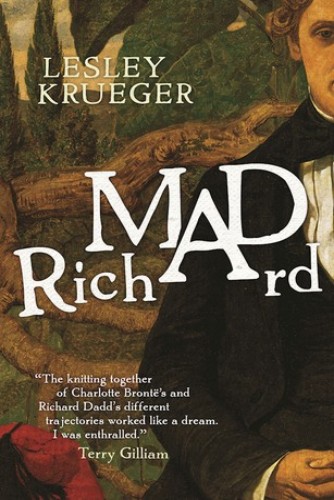
Mad Richard
کتاب های مرتبط
- اطلاعات
- نقد و بررسی
- دیدگاه کاربران
نقد و بررسی

Starred review from March 13, 2017
In this remarkable piece of historical fiction, Krueger (Drink the Sky) imaginatively delves into the life of Richard Dadd, who was well known in Victorian England first for his promising artistic career and then for his descent into murderous madness. Krueger deftly paints dual portraits of this fascinating character and Charlotte Brontë, whose interview with Dadd in Bedlam opens their reticulating story lines. Dadd’s narrative begins in his boyhood in 1817, lingers on his gradual rise as an artist in London, and ends with his incarceration and eventual deterioration in Bedlam in 1858. The trajectory, however, is only vaguely linear and subtly serves as a reflection of the equally blurred lines between Dadd’s genius and insanity. Brontë’s tale is smaller in scope, beginning just after the publication of her novel Villette in 1853 and ending just before her early death in 1855. The two story lines don’t always weave together seamlessly, but they do effectively juxtapose Dadd and Brontë, two very different people who travelled in similar circles during the same era and, more importantly, who were both entirely invested in what it means to be an artist. This question anchors the novel, adding depth and dimension to a terrific read.

January 1, 2017
On a cold January day in 1853, diminutive and curious Charlotte Bronte traveled to Bedlam to interview a broken Richard Dadd, one of the most celebrated artists of her day. A correspondence between their minds haunted her and perhaps altered her life.Well-known for her remarkable Jane Eyre, Bronte is seeking a new challenge, perhaps one that will keep her publisher, George Smith, interested in her for more than business reasons. Considering a social action novel, she arranges to meet Dadd, a man whose own fame will eventually rest upon his strangely compelling paintings of the liminal, particularly the fairies among us. His notions of doublings and mirrors intrigue her, but she abandons the project, returning to her isolated cottage. While several chapters return to Bronte, most twine back in time to trace Dadd's life from childhood through his fragmentation into mental illness. Screenwriter and novelist Krueger (The Corner Garden, 2003, etc.) uses her visual artistry to good effect in vividly portraying a squalid London in which talent doesn't always lead to fame or fortune. Exploring the vibrant cultural awakenings of the Victorian age, Krueger intriguingly populates her scenes with the artistic glitterati of the day. Elizabeth Gaskell and Charles Dickens grace the book along with Dadd's associates in The Clique, including Augustus Egg and William Frith. Those very awakenings--religious, political, and economic--nevertheless set obstacles to Bronte's freedom and trouble Dadd's mind. Yet the central premise linking Bronte to Dadd never quite works. Bronte suffers an existential malaise following the publication of Villette and her beloved George's silence. Her worries seem qualitatively different from Dadd's descent into an infamous madness that culminated in his own incarceration. An entrancing portrait of artistic minds confounded by the Victorian Age.
COPYRIGHT(2017) Kirkus Reviews, ALL RIGHTS RESERVED.

























دیدگاه کاربران